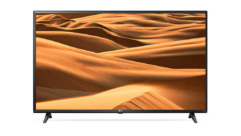
Get the TV You Need
Jul 17, 2008 1:17 PM,
By Jason Bovberg

A friend of mine is mulling an HDTV purchase, and he’s got that common tech-guy gut instinct of wanting to buy the most impressive equipment on the market—within financial reason. For this purchase (which he appropriately deems the centerpiece of a new home-entertainment system), he wants to devote a good chunk of his budget and get the “very best.” So, naturally, he’s got his sights fixed on 1080p. When he told me of these high-resolution intentions, I thought of his viewing habits and his viewing area, and I said, “Hold on, buddy.”
It goes without saying that 1080p is wonderful—in theory. If you’ve seen a demo of a 1080p HDTV displaying a true HD source, you know what I’m talking about. Detail is more precise than anything you’ve ever seen (even in nature), color and black levels are vivid and rock-steady, and you just stand there willing to murder your mother in order to implement that technology in your home. However, 1080p in practice is a very different beast. In truth, considering the majority of HD sources available today and into the foreseeable future—the resolution of which falls overwhelmingly in the 720p/1080i arena—most people fail to distinguish a quality difference between 1080p TVs and their lower-resolution (but still HD) brethren.
My buddy intends to use the set mostly for sports and DVDs. Mostly sports. At his local consumer-electronics store, he sees 1080p feeds pushed onto high-end 1080p sets, and he understandably goes into full-on Homer Simpson-drool mode. I have to explain to him that the source feed is very different from what he’ll get in real life. “Cable TV and satellite TV aren’t 1080p,” I say. “In fact, broadcast TV won’t be available in 1080p for years to come. The required bandwidth is insane! You’re getting all excited about something that doesn’t even really exist yet.”
We’ve also had the conversation about DVDs not even being high-definition. I think, deep down, he gets that. Or maybe he’s just humoring me. I tell him, “Your giant collection of DVDs might look the slightest bit better on an HDTV, thanks to upscaling, but they won’t look any better on a 1080p set than a 720p set.”
He just looks at me funny. “I don’t think that’s true.”
“Actually, on such a high-resolution display, the DVD format’s inherent limitations will probably become even more noticeable.” (And I’m not even sold on the benefits of upscaling technology.)
Then he gives me the typical comeback, complete with shrug. “I think you just pay attention to details too much. I don’t watch my movies that closely.”
Which begs the response: “Then why on Earth are you considering a 1080p set?”
Get the TV You Need
Jul 17, 2008 1:17 PM,
By Jason Bovberg

In fact, the only source material today that really takes advantage of a 1080p set’s resolution is Blu-ray disc and a few video games on the Sony PlayStation 2 (which comes with a built-in Blu-ray player). Personally, I’m already invested in the beauty of Blu-ray, and for that reason alone look forward to purchasing a 1080p HDTV. But my friend has, so far, never even considered the notion of purchasing a Blu-ray player. The feeling is understandable. After all, Blu-ray—the next-generation high-def video disc that beat out HD DVD in the recent format war (much to my chagrin, as I had already collected two dozen HD DVDs)—is on increasingly shaky ground itself. Will the format become the de facto DVD standard in our high-def age, or will it go the route of DVD-Audio (DVD-A) or Super Audio CD (SACD), two extraordinary high-res audio formats that sadly descended into niche-format territory? If Blu-ray never ascends beyond a niche market, and if my friend never invests in the technology, he’s lost just about any reason for buying a 1080p set.
But wait. I haven’t told you the size of his viewing area. It’s big. He wants this room to feel more like a theater as opposed to a room with a TV in it. That’s understandable. And in my casual view of the market, any TV larger than 50” is going to be 1080p—it’s just the way the size/resolution ratio works right now. So, he’s faced with a difficult decision: Go with a set that’s 50” or less, in which case (I believe), a 1080p purchase would be a complete waste of money (particularly considering that his seating area won’t be close to the TV), or go with a 58” or larger 1080p set, which costs thousands of dollars more but would give him the size and resolution he claims to desire.
It’s a tough choice. Diving headlong into HD is an expensive, spotty proposition, particularly when you consider that most people hang onto their TVs for about five years, then upgrade. Most people are overbuying—throwing away hundreds if not thousands of dollars on a technology that they will never fully take advantage of. I’ve visited too many homes in which owners try their best to expound on the visual superiority of their brand-new 1080p HDTV, and all the while, a regular HD (or even standard-def) cable signal or DVD is all they’re feeding into it. Sure, it looks good. But it doesn’t look any better than it would on a far cheaper display.
So, to all of your 1080p aspirants out there, do your homework before plunking down the cash. What are you really going to watch on this TV? Do you imagine yourself investing fully in Blu-ray? How large a TV do you need for the space you have? These are all important considerations, and when you weigh them all, you might find that 1080p just isn’t necessary and you could probably better direct the cash toward speakers or source material.
Jason Bovberg is a senior editor for Windows IT Pro and SQL Server magazine and a regular contributor to Residential AV Presents Connected Home. He specializes in networking, mobile and wireless, hardware, and home computing. He has more than 15 years of experience as a writer and editor in magazine, book, and special-interest publishing. He can be reached at [email protected].










